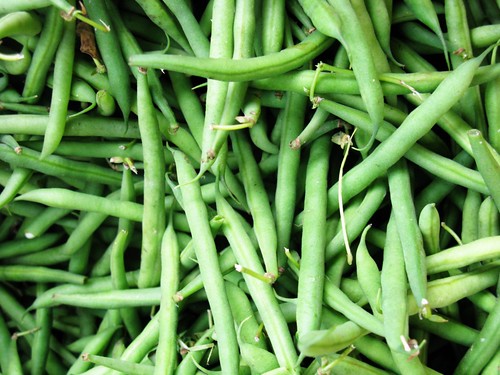 Whatever vegetables you plan to grow, you are bound to choose some of those key crops that are to be found in most vegetable gardens. These include seasonal favourites such as runner beans for summer, leeks for winter and purple sprouting broccoli for spring. Most gardeners with a vegetable plot will grow a few potatoes and some salad crops also. The most important thing to remember is that there is always more than one way to achieve a successful crop, but it is useful to have some guidelines to get you started.
Whatever vegetables you plan to grow, you are bound to choose some of those key crops that are to be found in most vegetable gardens. These include seasonal favourites such as runner beans for summer, leeks for winter and purple sprouting broccoli for spring. Most gardeners with a vegetable plot will grow a few potatoes and some salad crops also. The most important thing to remember is that there is always more than one way to achieve a successful crop, but it is useful to have some guidelines to get you started.
This article will give you some basic ground rules to follow in order to sow, grow and gather your favourite vegetables; and it helps you to decide which varieties to choose.
Beans, Broad
There are many different varieties of broad bean on offer but they are not nearly as widely grown as French and runner beans. Broad beans are highly nutritious and are packed with protein.
Sow
The seed of some varieties such as ‘Aquadulce Claudia’ and ‘The Sutton’ can be sown in the open ground I autumn. Sow seeds 20cm apart and 5cm deep. The seeds will germinate and the plants should overwinter, although occasionally young plants can be wiped out by extremely severe weather, particularly if the soil is heavy and wet.
Sow in November and stand them in a protected spot outdoors in late January or February. Plant out when the soil starts to dry out and warm up in early March.
Grow
Broad beans success in most soils provided they are well drained and not too acidic. If necessary, add lime in autumn every couple of years as a precaution.
Gather
Early sowings usually produce a worthwhile crop of beans in early summer. Pick them when young. The beans should just be showing through the pods.
Carrots
Although readily available and cheap to buy, carrots are worth growing for the wonderful flavour of young roots pulled fresh from the garden. They are not difficult to grow, but they are quite choosy about soil. If you cannot grow carrots in the open ground, you can certainly achieve beautifully tender roots in a container, box or raised bed.
Sow
Carrots can be sown directly into the open ground at any time from early spring through to early summer, according to variety. If you are growing carrots in rows, the seed should be in 2cm deep and the rows 15-20cm apart. The seedlings need to be thinned about 5cm apart for the roots to develop fully.
Grow
Do not add manure or garden compost to the soil in the autumn before planting, as lumps of organic matter often cause the roots to fork or become distorted. Simply apply a general purpose fertiliser about a month before sowing the seed and fork thoroughly into the ground.
Gather
Carrots are usually ready to harvest between 12 and 16 weeks after sowing; however, on light soils they can often be left in the ground for much longer.
Potatoes
The potato is our most popular vegetable, a staple of our diet, despite its relatively recent introduction from South America, in the 16th century. It owes its success largely to its versatility: chips, roast, mashed, boiled or salad potatoes – something to suit every taste.
Sow
Seed potatoes are actually small tubers that have been certified as virus-free. They are normally produced in colder parts of the UK such as Scotland, where there are far fewer virus spreading aphids.
Seed potatoes are available from January; this is the best time to buy them because you have the widest choice and you can control their storage conditions until it is time to plant them. Buying early allows plenty of time to chit, or sprout, the potatoes before planting in mid to late march. They usually take around six weeks to sprout.
As soon as you have bought your seed potatoes unpack them, lay them out in trays and store them in a cool place. When you are ready to chit them in late winter, place the tubers in egg boxes, or trays filled with crumpled newspaper, with the ‘rose’ end facing upwards. This is the end with the most eyes or growth buds. Do not worry if both ends of the tuber look the same; varieties vary and some produce more shoots than others, stand the potatoes in a cool light place to allow the shoots to develop.
 Grow
Potatoes are heavy feeders and they need a good supply of nitrogen in the soil to produce a worthwhile crop, mainly because the tubers are actually swollen stems rather than roots.
Dig the ground it autumn and add plenty of well-rotted manure. Plant out in mid to late March and be prepared to protect the emerging shoots with fleece.
When the shoots are 10-15cm high they should be earthed up. This can be done with a draw hoe, the back of a rake or with a border spade.
Potatoes need lots of water as they grow. If the soil is too dry the tubers will fail to develop.
Gather
Potatoes are usually ready to harvest once the flowers have faded or the flower buds have developed and dropped.
This article was written by gardening lover Yasmin Holloway. For more great gardening advice visit http://www.gardenhealth.com/